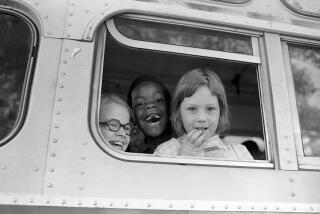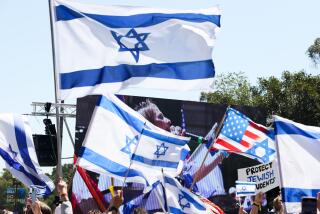Parallel Schools a Mirror of Kosovo’s Ethnic Divide
- Share via
PRISTINA, Yugoslavia — The Hasan Pristina elementary and junior high school, its hallways bright with cheerful paintings and chattering children, doesn’t look like a war zone.
But climb the stairs to the top floor and one encounters a crudely constructed floor-to-ceiling red brick wall, put up seven years ago to block off ethnic Albanian classrooms from the Serbian side of this divided school building in crisis-torn Kosovo.
“This is our version of the Berlin Wall,” Vice Principal Rasim Berdyna said, his voice tinged with bitterness.
The struggle in Yugoslavia’s Kosovo province is not just a military and political battle between separatist-minded ethnic Albanians and a Serbian-dominated government. It also extends deep into society and its institutions, especially schools.
Even before this year’s upsurge of fighting, which has left more than 1,000 dead, Kosovo society was fiercely divided. That division is nowhere more clear than in the parallel system of ethnic Albanian schools that operates outside Yugoslavia’s legal educational framework.
The system’s existence reflects deep separation and hatred that must somehow be addressed if any stable settlement is to emerge from the fragile peace process that has begun in Kosovo, where 90% of the population is ethnic Albanian.
At the same time, Kosovo’s Albanian schools offer hope for the future: As the premier accomplishment of the quasi-underground government headed by Ibrahim Rugova, this educational system could ultimately prove an important base for successful autonomy here.
Ethnic Albanians, after all, are running such key institutions as schools in the face of enormous obstacles. This existing system could be plugged almost directly into any agreement on political autonomy.
Yugoslav authorities--acting under intense international pressure, including the threat of North Atlantic Treaty Organization airstrikes--have agreed to move toward granting such autonomy to Kosovo.
Elections promised for next year would be a key step in that process. If successful, self-rule for Kosovo in turn could restore normalcy to the province’s schools.
But for now, classrooms are as much battlegrounds as oases of learning.
“It is a state of war, even here,” said Ali Gashi, the 52-year-old principal of Hasan Pristina, the Albanian portion of the divided building. “The only difference is you can’t hear the shots. . . . For the past eight years, there’s no communication with the Serbs, except when our children are attacked on the school grounds, which happens from time to time. . . . It’s pure segregation, apartheid.”
Organized by Rugova’s shadow government without public funding or any basis in law, this extraordinary school system is financed by unofficial taxes paid by ethnic Albanians within Kosovo and those who have emigrated elsewhere.
The system normally serves about 270,000 elementary and junior high school students, nearly 60,000 high school students and 16,000 university students. The number of students in Pristina, the provincial capital, has swollen this fall as children fled fighting in the countryside, while schools have stopped functioning in many rural villages.
The roots of the current situation go back to 1989, when Kosovo--part of Serbia, the dominant republic in Yugoslavia--lost the political autonomy it had enjoyed since 1974. On July 2, 1990, as relations with the Yugoslav government deteriorated, ethnic Albanians in Kosovo declared independence--leading eventually to the establishment of Rugova’s unofficial government.
In August 1990, the Serbian parliament repealed the educational curriculum in Kosovo that had been developed under ethnic Albanian control and replaced it with a Serbia-wide program, which affected the teaching here of history, geography, art, music and the Albanian language.
Ethnic Albanian educators refused to accept the new program.
Serbian authorities then cut off funding for their schools, first at the secondary level, then primary and junior high.
Serbs Take Over Educational Facilities
At the start of the 1991-1992 school year, Serbian police blocked ethnic Albanian students from entering many school and university buildings.
By January 1992, most high school and university education was taking place in private homes. Many elementary and junior high school students could still use parts of their old buildings, but even in those cases the administrative structure became an unofficial parallel system.
Gjin Gazulli Electrotechnical High School--which has a proud 40-year history, most of it in a fine building--now meets in a 12-room house, which provides an office and 11 classrooms for educating 980 students in three shifts a day. About 70 of the students fled from the countryside to Pristina. Classes in each subject last for 30 minutes, and the maximum time spent at school by any one student is less than four hours.
Students sit shoulder to shoulder on benches and appear to study hard. Bitterness over loss of school buildings to the dominant Serbs runs deep.
“Those schools are our schools,” said Jeton Ramadani, a 15-year-old Gjin Gazulli student. “We were forced to go and study under a different curriculum, but we opted out. We were forced, we resisted, and that’s why we’re here.”
‘The Curriculum Was Just a Trigger’
Nysret Simnica, a teacher at Gjin Gazulli, said it is more complicated than that.
“The justification of the Serbian state was that the difference in the curriculum was the key, and that we abandoned the buildings,” he said. “That’s not true. We were thrown out. . . . The curriculum was just a trigger.”
Not everyone is completely unhappy about the parallel system, despite its problems, because it is, after all, run by ethnic Albanians without Serbian control.
“It’s important for my son to be educated here,” said Fetije Arifi, mother of a first-grader at Hasan Pristina. “It’s one of the best schools. I prefer my son to be taught in Albanian.”
Hasan Pristina now has about 1,570 students, including 170 from the countryside.
“These [displaced] children are very traumatized,” said Gashi, the principal. “They’re very unstable, very sensitive, they cry very often. They have no previous educational records with them. Their friends and other people try to help out with clothing and books.”
Between 7 a.m. and 8 p.m., Hasan Pristina runs three four-hour shifts of classes. It also provides space for a shift of about 450 ethnic Albanian fifth- to eighth-graders from another school that lost access to its building.
The extraordinarily deep roots to the hatred and resentment on both sides of the struggle in Kosovo are reflected in how long-ago events are spoken of as if they happened almost yesterday.
“The aim here is to eradicate physically an entity,” Gashi charged. “They stop your food. They stop your wages. The issue is not just denying rights. The issue is physical eradication. This started not from today, but from 150 years ago when the Serbs tried to wipe out the Albanians. This is the third time they’ve tried to do it. . . . In 1921, Serbia burned out the villages in Kosovo so [the ethnic Albanian farmers] would move to Turkey.”
Such interpretations of history, as well as current events, have an inevitable impact in the classroom.
All the children suffer the effects of the many months of fighting in the countryside, Hasan Pristina English teacher Shpend Kallaba said.
“Their cousins, their aunts, their uncles--they have so many relatives there,” Kallaba said. “They were in touch with them directly. They are so worried about the situation. They are psychologically damaged.”
Part of the school’s goal, Kallaba added, is to instill national pride in the students in the face of Serbian dominance, to make them clearly understand that “this is your place, this is your land.”
Political Agenda Alarms Belgrade
This aspect of the schools is particularly galling to Serbian authorities. A pamphlet published by the Federal Secretariat of Information in Belgrade, the Yugoslav and Serbian capital, blasts the ethnic Albanians’ system for “teaching . . . according to nationalist and separatist programs, in nonadequate premises.”
Yet compared to what would happen in a true totalitarian dictatorship, where growth of an independent educational system run by a separatist-minded ethnic group would not likely be tolerated, the very existence of this system might seem to reflect a certain kind of tolerance--or at least lack of control--by Serbian authorities.
However, the separate system has not come easily, Gashi said.
“Since 1991, we’ve been subjected to maltreatment of various kinds--beatings, imprisonment,” he said.
Gashi was convicted of “resistance and calling for resistance to Serbian laws and administration” and received a suspended six-month jail sentence that may still be carried out, he said.
Gashi has a litany of additional complaints.
A statue of Hasan Pristina, a local ethnic Albanian hero, used to stand in front of the school but was taken away.
“In its place,” he said, “they put a statue of Dositej Obradovic”--a Serb whose name now adorns the rival side of the school building.
“They took the best classrooms, the places with equipment for different subjects, such as the chemistry cabinets, and we have been left with the worst,” Gashi added. “Anything they did, they used the police as backup.”
For example, the first attempt to take down the Hasan Pristina statue came on a weekday and was prevented by teachers, Gashi said.
“They came back and took it down on a Sunday,” he said. “On that Sunday, about four or five of the staff were here and they protested. They were arrested, and the statue was taken.”
Gashi added, however, that despite all the troubles and pain, he finds one consolation in the escalation of Kosovo’s problems to the level of a dramatic international crisis: “A new boost of morale has come from the support of the West, of America. Now at least we know someone is hearing about what is happening.”
More to Read
Sign up for Essential California
The most important California stories and recommendations in your inbox every morning.
You may occasionally receive promotional content from the Los Angeles Times.










